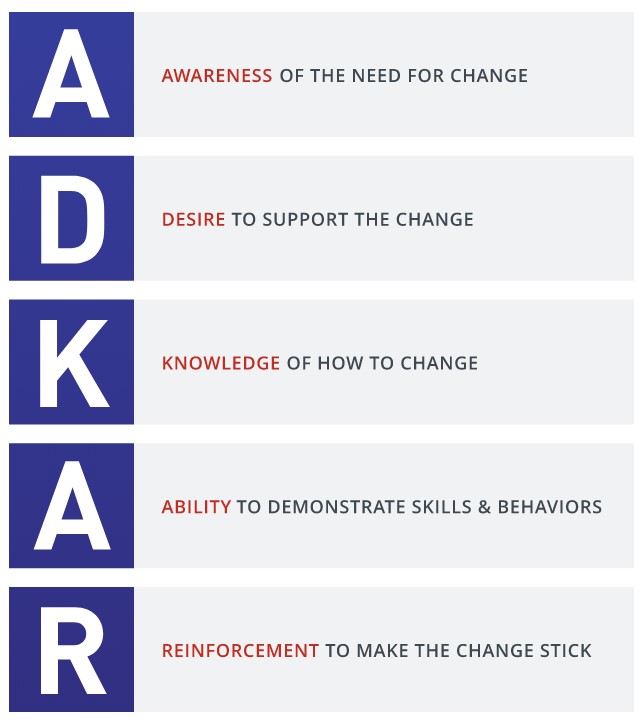Introduction to the ADKAR Model
If your essay or report focuses on change management, the ADKAR model is a valid tool for ensuring that your assignment receives a high mark. Originally created by Prosci, a change management consultancy firm, ADKAR includes five dimensions, namely awareness, desire, knowledge, ability and reinforcement (Prosci, 2020). What separates ADKAR from other frameworks of change management (e.g. Lewin’s framework of change) is that this model is used by Prosci when conducting change processes for their clients. This means that ADKAR has been tested empirically and provides measurable results to modern businesses (Prosci, 2020). If you are interested in using the ADKAR model in your next coursework, we have prepared a short guide detailing how to apply this framework.
Key Elements of the ADKAR Model
The following figure graphically summarises all five stages included in the ADKAR model.
Figure 1: The ADKAR Model
Source: Prosci (2020, n.p.)
The following discusses the individual processes included in ADKAR to give some examples of using this model in practice.
Awareness of the Need for Change
To create awareness of the need for change, a hypothetical company would need to issue either verbal or written communications highlighting why change is necessary for a firm’s survival (Efe and Demirors, 2019). To achieve this aim, organisations typically use electronic tools such as BaseCamp to reach the largest possible number of workers in one or two days. When necessary, a business can conduct meetings with shareholders and employee teams to personally communicate how the change will positively affect future development.
Desire to Support the Change
Even if an organisation succeeds in fostering awareness, there are no guarantees that the stakeholders would be motivated to participate in the change process. In a well-known example of effective change management, in 2004 Shell created a dedicated steering group the aim of which was re-defining the roles of the firm’s CEO, employee teams and its top executives (Beale, 2005). Such a clear change strategy meant that each worker was aware of how their efforts contributed to the change process, increasing motivation.
Knowledge of How to Change
To achieve the change objectives, workers and managers need to know what exact skills are of value to the organisation. At this stage, a hypothetical organisation should focus on formal employee training and development programmes including seminars, mentorship programmes and online learning (Thakur and Mangla, 2019). While this will increase job stress, imparting new skills to the employees will ensure that the workforce remains committed to the change process.
Ability to Demonstrate Skills and Behaviours
The skills taught during employee training and development will not provide any value unless a company also changes the roles and functions of its workers. For instance, in an attempt at changing its culture of crunches, Rockstar Games, a popular video game developer and publisher, currently allows its workers to provide anonymous feedback and participate in flexible working arrangements (Schreier, 2020). This enables the employees of Rockstar to demonstrate their decision-making and project planning skills.
Reinforcement to Make the Change Stick
Unless a company ensures the long-term commitment to change, the above measures will only last for two or three months. To reinforce change, companies typically establish new reward management systems encouraging employees to display desired behaviours such as increased creativity (Al-Moosa and Sharts-Hopko, 2017). Another valuable measure is partnering with Prosci or similar change management agencies to conduct monthly audits of a company’s commitment to sustaining change. Such performance outcomes are typically measured by comparing revenues pre- and post-change and assessing employee performance following the implementation of new organisational measures.
While the ADKAR model enables companies to follow a five-stage change strategy, not all change processes can be accurately summarised using the above concepts. As an illustration, if an organisation’s employees report high levels of stress and display high turnover intentions, conducting additional training and development exercises would not be beneficial (Prosci, 2020). In some cases, the employees can already be aware of the need for change or suggest specific change processes when meeting with managers. When addressing their demands, the employers would not need to raise awareness of change any further.
Using the ADKAR Model
When Should I Use the ADKAR Model?
- In reports and courseworks focusing on change management within real and hypothetical organisations.
- In dissertations when structuring the framework of the study and writing the literature review chapter.
- In essays when you need to compare the benefits and limitations of different change management models.
- In presentations on change management to summarise your change recommendations within one or two slides.
How Should I Structure the ADKAR Model?
- Use a table with the ADKAR stages as rows to provide brief details of the change process.
- Use a SmartArt figure to provide individual recommendations for each step of ADKAR.
- Use plain text with headings and sub-headings to suggest detailed recommendations on current and future change.
Where to Find Data for Using ADKAR?
- Reference company reports giving examples of practical measures corresponding to each stage of ADKAR.
- Compare ADKAR to academic literature and change management to find any inconsistencies between this model and state-of-the-art empirical data.
Our Services and the ADKAR Model
Our professional essay and report writers will be happy to use the ADKAR model if this framework is required by your tutor or is relevant to your assignment topic. We will gather up-to-date data on how different companies approach change processes and how these can be structured using the ADKAR framework. Our writing services also include the provision of detailed practical recommendations on what steps should be taken by real-life businesses to conduct an effective ADKAR-driven change process. When necessary, we can also discuss the benefits and shortcomings of ADKAR as a theoretical model. In addition to ADKAR, our team can also use other approaches to change management (e.g. Kotter’s 8-Step Model) and compare the results to ADKAR. If there is a strict word count limit, we will create unique figures and tables to fit the discussion of ADKAR into a relatively short assignment. Feel free to contact us and we will provide a custom estimation of what should be done in your particular case.
References
Al-Moosa, N. and Sharts-Hopko, N. (2017) “Using Change Management to Redesign Oman׳ s Health Professions Education Sector”, Health Professions Education, 3 (2), pp. 108-112.
Beale, N. (2005) “Oil and Troubled Waters”, [online] Available at: https://hbr.org/2005/11/oil-and-troubled-waters [Accessed on 22 May 2020].
Efe, P. and Demirors, O. (2019) “A change management model and its application in software development projects”, Computer Standards & Interfaces, 66 (1), pp. 1-13.
Prosci (2020) “Adkar”, [online] Available at: https://www.prosci.com/adkar [Accessed on 22 May 2020].
Schreier, J. (2020) “18 Months After Red Dead Redemption 2, Rockstar Has Made Big Cultural Changes”, [online] Available at: https://kotaku.com/18-months-after-red-dead-redemption-2-rockstar-has-mad-1842880524 [Accessed on 22 May 2020].
Thakur, V. and Mangla, S. (2019) “Change management for sustainability: Evaluating the role of human, operational and technological factors in leading Indian firms in home appliances sector”, Journal of Cleaner Production, 213 (1), pp. 847-862.


